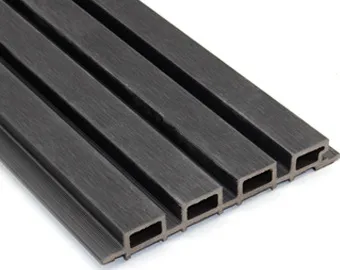Wall panels, both for indoor and outdoor applications, play a crucial role in defining the aesthetic and functional quality of a space. The choice of material for these panels can significantly affect their appearance, durability, maintenance requirements, and suitability for specific environments. Let’s explore the differences between Wall Panel WPC (Wood Plastic Composite), Wall Panel Wood, and other commonly used materials for wall cladding and paneling.

Wall Panel WPC (Wood Plastic Composite)
Advantages:
- Durability: WPC panels are known for their durability and resistance to weather conditions, making them suitable for both indoor and outdoor use. They do not warp, crack, or fade easily.
- Low Maintenance: WPC panels require minimal maintenance, as they do not need to be painted, stained, or sealed regularly.
- Eco-Friendly: Made from a blend of recycled wood fibers and plastics, WPC panels are an environmentally friendly choice.
- Versatility: Available in a variety of colors and textures, WPC panels can mimic the appearance of natural wood while offering enhanced durability.
Disadvantages:
- Cost: WPC panels can be more expensive upfront compared to traditional wood panels, though their low maintenance costs can offset the initial investment over time.
Wall Panel Wood
Advantages:
- Aesthetic Appeal: Wood panels offer a classic and timeless look that adds warmth and natural beauty to any space.
- Versatility: Wood can be stained or painted in numerous colors and finishes, allowing for a wide range of design possibilities.
Disadvantages:
- Maintenance: Wood panels require regular maintenance, including staining, painting, and sealing, to protect against moisture, rot, and pests.
- Susceptibility to Environmental Conditions: Wood can warp, crack, or rot when exposed to moisture, making it less suitable for outdoor use without proper treatment.
Other Materials
- PVC Panels: Lightweight and water-resistant, PVC panels are a cost-effective option for indoor use, particularly in damp areas like bathrooms. However, they may not offer the same aesthetic appeal as wood or WPC.
- Metal Panels: Offering a modern look, metal panels are durable and resistant to fire and pests. They’re suitable for both indoor and outdoor use but can be more expensive and require specific installation techniques.
- Stone Veneer: Stone veneer panels add a natural and luxurious element to walls, suitable for both interiors and exteriors. They are durable but can be expensive and heavy, requiring additional support during installation.
- Fiber Cement: Fiber cement panels are a durable, fire-resistant option that can mimic the look of wood, stone, or brick. They are suitable for outdoor use but may require painting or sealing to maintain their appearance.
Conclusion
Choosing the right material for wall panels depends on various factors, including the desired aesthetic, budget, maintenance willingness, and environmental conditions of the installation site. WPC panels offer a balanced blend of durability, low maintenance, and environmental friendliness, making them a versatile choice for both indoor and outdoor applications. Wood panels, while offering natural beauty, require more upkeep. Other materials like PVC, metal, stone veneer, and fiber cement provide additional options, each with its own set of advantages and considerations.


